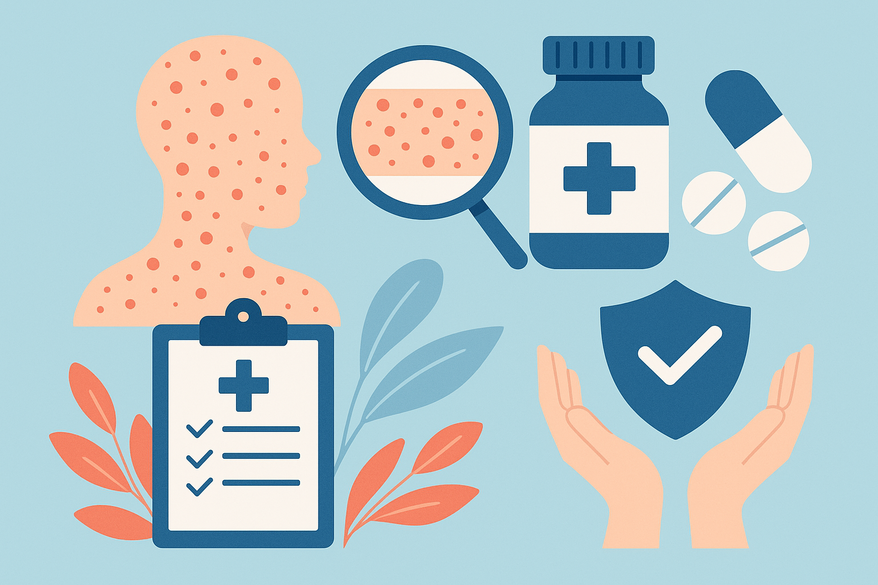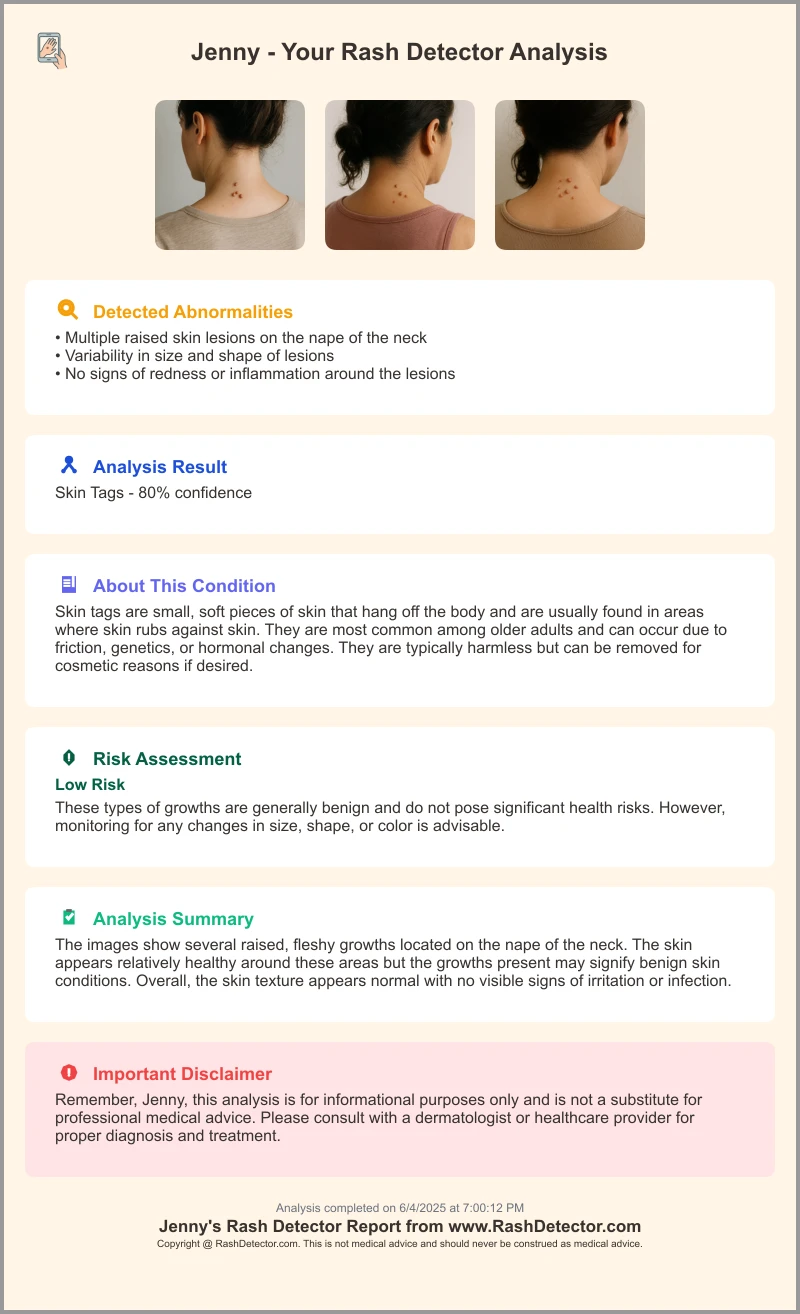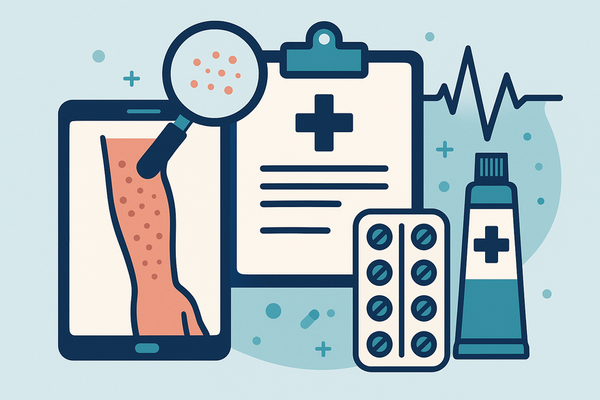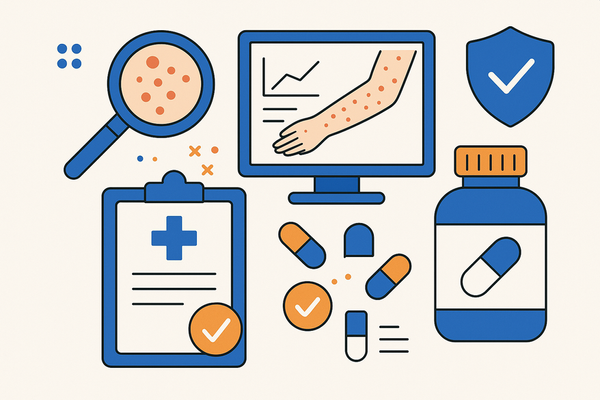Medication Rash Treatment: A Comprehensive Guide
Learn to identify and manage drug-induced skin reactions with our comprehensive guide on medication rash treatment, diagnosis, and prevention tips.

Estimated reading time: 8 minutes
Key Takeaways
- Identify drug-induced rashes: Recognize symptoms like redness, hives, scaling, and blistering linked to medications.
- Accurate diagnosis: Use medical history, physical exam, and tests to pinpoint the cause and guide treatment.
- Treatment strategies: Discontinue the offending drug, use antihistamines, corticosteroids, or epinephrine for severe reactions.
- Prevention tips: Maintain updated allergy records, discuss cross-reactivity, and adopt skin-friendly lifestyles.
- When to seek help: Immediate care for rapid spread, blisters, mucous membrane involvement, or signs of anaphylaxis.
Table of Contents
- Understanding Medication-Induced Rashes
- Diagnosing Medication Rashes
- Detailed Medication Rash Treatment Options
- Management and Prevention Tips
- When to Seek Medical Help
- FAQ
Section 1: Understanding Medication-Induced Rashes
Keyword: medication rash treatment
A medication-induced rash is a skin reaction triggered by a drug, not by an infection, autoimmune condition, or environmental factor. These rashes occur when a medication causes changes in the skin’s cells or immune system.
Key differences from other skin reactions:
- Contact dermatitis stems from skin contact with irritants or allergens.
- Viral exanthems are rashes caused by viral infections.
Three main causes of medication-induced rashes:
- Drug allergies involving immune responses
– The body mistakes the drug or its byproduct as harmful.
– Triggers histamine release and inflammatory cells. - Non–immune-mediated side effects
– Direct toxic effect of the drug on skin cells.
– Dose-related and can occur on first exposure. - Drug interactions altering reaction profiles
– One drug changes how another is broken down.
– Leads to higher levels of the active drug or its metabolites.
Common symptoms:
- Redness or erythema of the skin
- Hives: itchy, raised welts that may merge
- Scaly or thickened patches
- Dark red or purple blotches
- Blistering or peeling in severe cases
Understanding the root cause helps guide proper medication rash treatment.
Source: Children’s National – Drug rashes health library
Section 2: Diagnosing Medication Rashes
Keyword: medication rash treatment
Accurate diagnosis steers the right medication rash treatment and prevents harm from mismanagement.
Step 1: Medical history review
– Document timing of drug start and rash onset.
– Record any past drug reactions and family history.
Step 2: Physical examination
– Check rash pattern: localized vs. widespread.
– Note morphology: bumps, hives, blisters.
– Inspect mucous membranes (eyes, mouth, genitals).
Step 3: Diagnostic tests as needed
– Blood tests: eosinophil count, liver and kidney panels.
– Skin biopsy: for atypical, persistent, or severe cases.
A precise diagnosis ensures you stop the right medication and choose the best treatment path. For additional insights into drug-induced rash symptoms, see our article “Identifying and Managing Drug-Induced Rash Symptoms”.
Sources:
• Mayo Clinic – Drug allergy diagnosis and treatment
• Children’s National – Drug rashes health library
For an instant second opinion, try Rash Detector, an AI skin analysis app that provides a detailed summary based on photos of your rash.

Section 3: Detailed Medication Rash Treatment Options
Keyword: medication rash treatment
Treating a medication-induced rash centers on removing the trigger and relieving symptoms.
Core principle
• Immediate discontinuation or adjustment of the offending drug under medical supervision.
– Reduces further exposure and stops progression.
– Involves consulting your prescriber before making any changes.
Symptomatic treatments
• Antihistamines (e.g., diphenhydramine, cetirizine)
– Block histamine to ease itching and swelling.
– Non-sedating options (cetirizine) are preferred for daytime use.
• Corticosteroids
– Topical steroids for mild to moderate rashes.
– Oral steroids (prednisone) for widespread or severe inflammation.
• Epinephrine for anaphylaxis
– Auto-injector for severe allergic reactions.
– Saves lives by reversing airway constriction and low blood pressure.
Supportive home care
• Cool compresses relieve heat and itch.
• Gentle, fragrance-free moisturizers to restore skin barrier.
• Loose, breathable clothing to reduce friction.
Severe reaction protocols
• Hospitalization for Stevens–Johnson syndrome or toxic epidermal necrolysis.
• Wound care similar to burn units: sterile dressings, pain control, fluid balance.
Alternative strategies if drug is essential
• Drug desensitization under allergist guidance.
• Substitution with a non-cross-reactive medication.
Section 4: Management and Prevention Tips
Keyword: medication rash treatment
Symptom management while healing
• Avoid heat, friction, and scratching to limit spread and infection.
• Follow your prescribed antihistamine or steroid regimen exactly.
• Use mild, fragrance-free cleansers and moisturizers to keep skin barrier strong.
Prevention strategies
• Always inform every healthcare provider of past drug reactions.
• Keep an up-to-date medication and allergy list—consider a wallet card or medical alert bracelet.
• Ask about cross-reactivity risk when prescribed new medicines.
To learn how to pinpoint causes and prevent future episodes, check “Rashes Trigger Identification: Your Guide to Preventing Outbreaks”.
Lifestyle and skincare recommendations
• Balanced hydration: drink water and use moisturizers.
• Gentle exfoliation only after rash fully resolves.
• Sun protection: use SPF on areas that had rashes to prevent pigment changes.
Consistent prevention reduces the risk of recurring medication-induced rashes and enhances safety.
Section 5: When to Seek Medical Help
Keyword: medication rash treatment
Some signs require immediate professional evaluation and could be life-threatening.
Urgent red flags
• Rapid rash spread or involvement of >30% of body surface area.
• Signs of anaphylaxis:
– Difficulty breathing, wheezing.
– Swelling of face, lips, tongue, or throat.
– Chest tightness, fainting, dizziness.
• Blistering, peeling skin, or mucous membrane involvement (eyes, mouth, genitals).
Prompt medical care ensures correct medication rash treatment and prevents complications.
FAQ
Q1: How soon after starting a medication can a rash appear?
A: Reactions vary—hours for immediate allergies to several weeks for delayed responses.
Q2: Will the rash resolve after stopping the drug?
A: Most rashes improve within days to weeks, but persistent cases may need ongoing treatment.
Q3: Can I take the same medication again?
A: Not without specialist evaluation. Desensitization protocols or alternative drugs may be safer.
Further reading:





